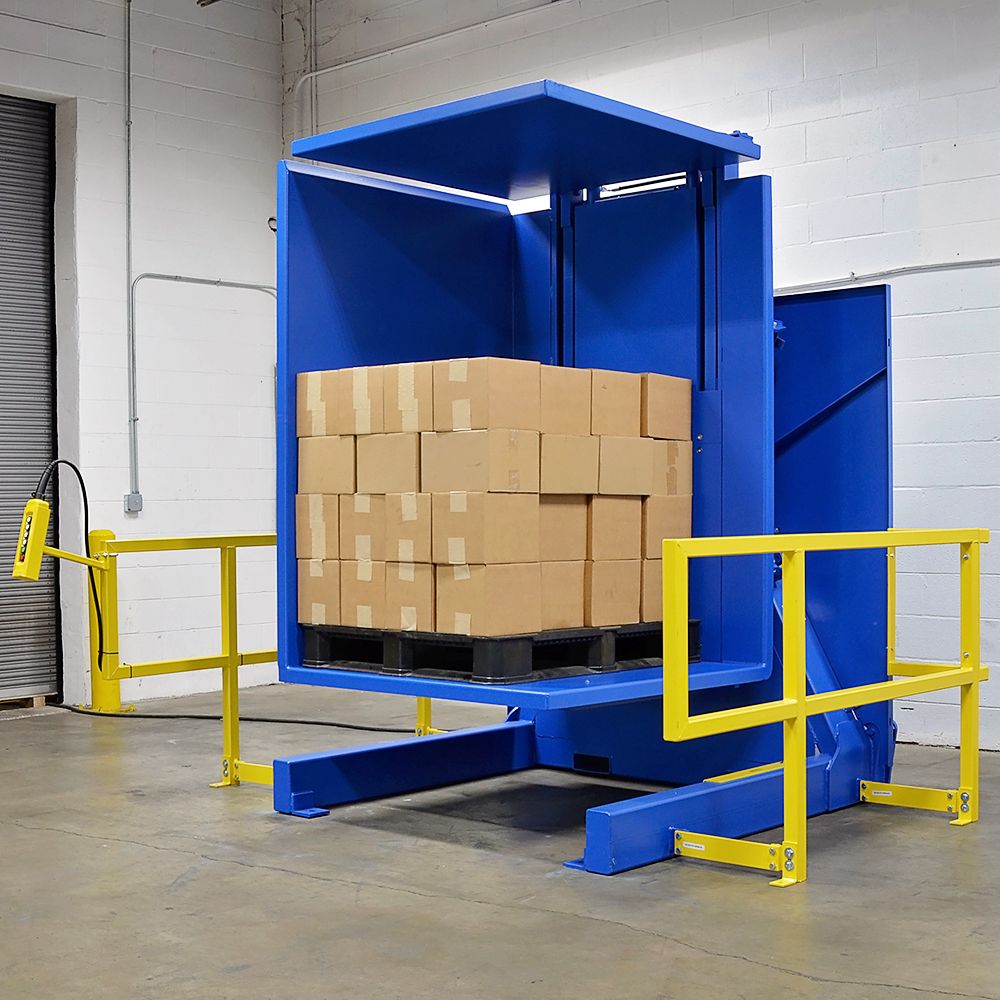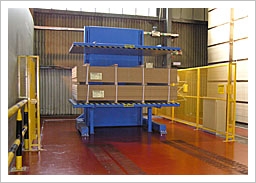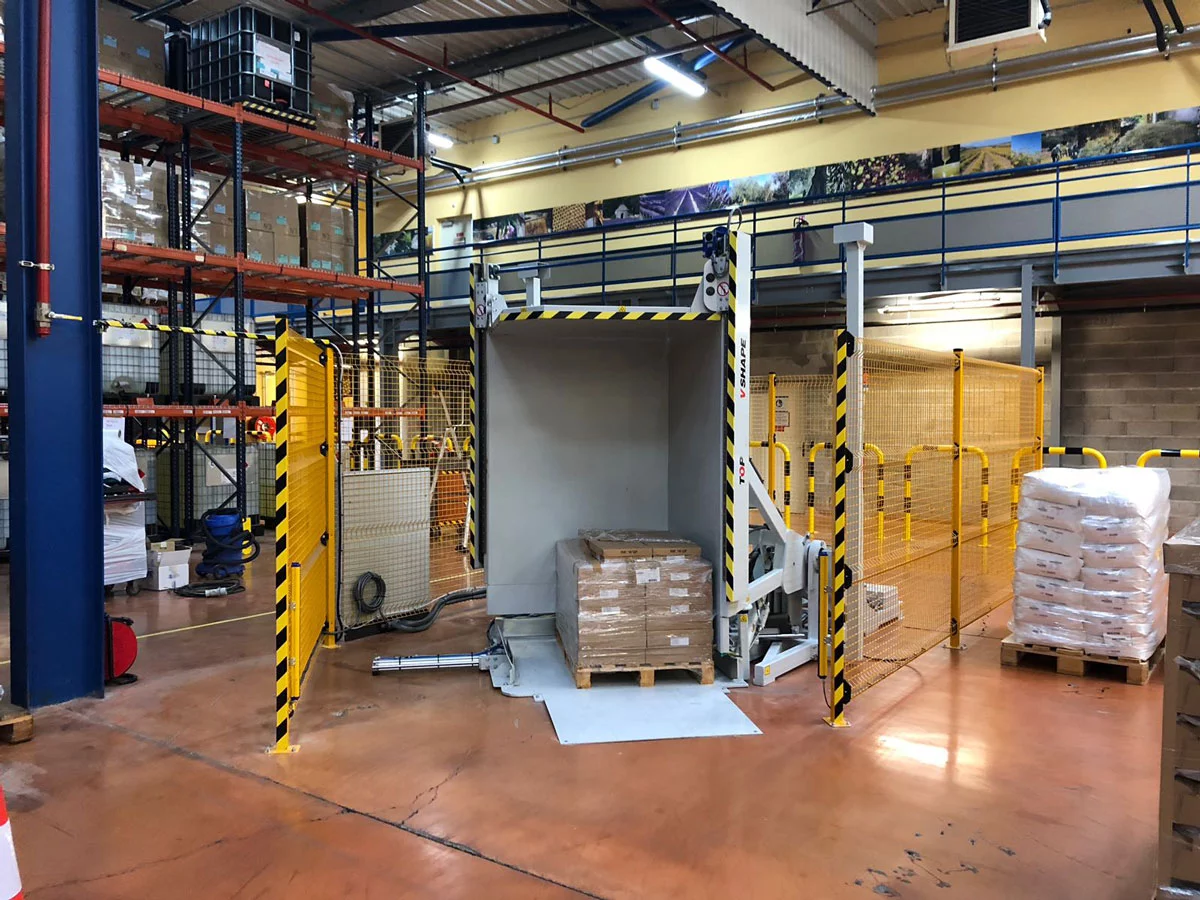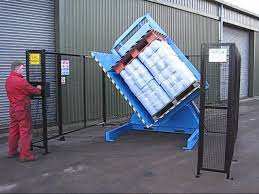Is Your Italy Factory Struggling with Ergonomic Handling in Boutique Production Plants? Try a Pallet Changing Machine
Running a boutique production plant in Italy comes with a unique set of challenges. You create high-quality, specialized products, but your processes often rely on manual labor. This can lead to bottlenecks, especially in logistics and handling. Your team might be struggling with the physically demanding task of moving goods from one pallet to another, leading to fatigue, potential injuries, and a slowdown in the entire production line. This constant strain on your workers is a hidden cost, impacting morale and your bottom line. What if there was a way to solve this ergonomic nightmare, increase speed, and protect both your team and your products? The solution might be simpler and more effective than you think: a pallet changing machine.
A pallet changing machine is a piece of automated equipment designed to transfer a full load of goods from one pallet to another without manual intervention. For Italy's boutique production plants, it directly addresses ergonomic handling struggles by eliminating the need for workers to lift heavy boxes or bend in awkward positions. This automation drastically reduces the risk of workplace injuries, improves operational speed, and protects valuable products from damage during transfer.

I have seen this problem in many factories throughout my career. Owners are proud of their products but frustrated by these small, nagging inefficiencies. They see the physical toll on their employees and worry about safety regulations. You want to maintain the "Made in Italy" quality, but you also need to be competitive and efficient. This is not just about moving boxes; it's about creating a safer and more productive work environment. Let’s explore how this technology can be a game-changer for your facility.
What exactly is a pallet changing machine and how does it work?
You have probably heard about automation, but the term "pallet changing machine" might sound complex or intimidating. You might wonder if it’s a massive, complicated system that will be difficult to integrate into your specialized boutique plant. This hesitation can cause you to stick with the old, manual methods. But continuing to rely on manual pallet swapping means accepting the risks of worker injury, product damage, and slow-moving operations. A pallet changing machine is actually a straightforward and powerful solution that solves these problems directly.
A pallet changing machine, also known as a pallet inverter or pallet exchanger, is a mechanical system that securely clamps a loaded pallet, rotates or pushes the load, and allows you to replace the original pallet with a new one. This process is done quickly and automatically, eliminating the need for your team to restack goods by hand. It's designed for simplicity and safety.

When I first started as an engineer, I saw the manual process firsthand. Workers would spend 20-30 minutes breaking down a single pallet, box by box. It was slow, and back injuries were common. The first time I saw a pallet inverter in action, it felt like magic. A task that took two people half an hour was completed by one operator in under a minute. It was a clear demonstration of how smart technology can transform a workspace. The machine isn't about replacing workers; it's about giving them better tools to do their jobs safely and efficiently.
How the Technology Functions
A pallet changing machine is a very logical piece of equipment. Its main purpose is to separate a product stack from its pallet. Different models accomplish this in slightly different ways, but the core principles are similar. They are designed to be robust and reliable, handling heavy loads with precision.
- Clamping: The process begins when a forklift places the loaded pallet into the machine. The machine uses powerful, yet gentle, pressure-adjustable clamping walls to secure the product stack. This ensures that the goods do not shift or fall during the operation, which is critical for the fragile or high-value items often found in Italian boutique production.
- Inverting or Pushing: Once clamped, the machine performs its main action. Some models, called pallet inverters, rotate the entire load by 180 degrees. The original pallet is now on top, ready to be removed and replaced. Other models, called pallet exchangers or pushers, hold the product in place while pushing it smoothly from the old pallet onto a new one placed adjacent to it.
- Pallet Replacement: With the load securely held, the operator can easily remove the old pallet. This might be a wooden pallet used for in-house production that needs to be swapped for a plastic or shipping-compliant pallet. A new pallet is inserted, and the machine reverses the process, gently placing the load onto the new base.
The entire cycle is typically controlled from a simple operator panel. Modern machines have safety features like light curtains and physical guarding to ensure the operator is never in a dangerous position.
Comparing Manual vs. Machine Pallet Changing
The difference between the traditional method and using a pallet changer is dramatic. To understand the impact, it helps to see a direct comparison.
| Feature | Manual Pallet Changing | Machine Pallet Changing |
|---|---|---|
| Time per Pallet | 15-30 minutes | 1-2 minutes |
| Labor Required | 1-2 workers | 1 operator |
| Physical Strain | High (bending, lifting, twisting) | Minimal (pushing buttons) |
| Risk of Injury | High (back, shoulder, repetitive strain) | Extremely Low |
| Product Damage Risk | Moderate (drops, impacts) | Very Low (load is secured) |
| Process Consistency | Low (depends on worker speed/fatigue) | High (predictable cycle time) |
This table shows why the investment is so compelling. You are not just buying a machine; you are buying speed, safety, and reliability. This is a foundational improvement that impacts your entire downstream process.
How can a pallet changer solve ergonomic handling challenges in Italy's boutique plants?
In Italy, you value your skilled artisans and dedicated workers. They are the heart of your boutique plant. But this also means you have a deep responsibility for their well-being. Repetitive lifting and awkward postures are not just inefficient; they are dangerous. These ergonomic risks lead to chronic pain, serious injuries, and costly worker compensation claims. The problem silently erodes your team's health and your company's productivity. A pallet changer is not just a piece of equipment; it is a direct solution to this critical human-centric challenge.
A pallet changer solves ergonomic challenges by completely removing the most physically stressful tasks from your workers. It automates the heavy lifting, bending, and twisting required for manual pallet swapping. This directly reduces the risk of musculoskeletal disorders (MSDs), helps you comply with Italy’s strict workplace safety laws, and creates a healthier, more sustainable work environment for your team.

I remember visiting a food processing plant where the owner, a man named Marco, told me his biggest worry was his aging workforce. His most experienced employees had been with him for over 20 years. He said, "Vincent, they have the knowledge, but their bodies are tired. I see them wince when they lift a heavy box." This is a common story. Boutique plants often rely on experience and skill, and you cannot afford to lose your best people to preventable injuries. By introducing a pallet changer, Marco was able to move his experienced team members into supervisory or quality control roles, while the machine handled the back-breaking labor. Their health improved, and their valuable knowledge was retained.
The Ergonomic Risks of Manual Handling
Ergonomics is the science of designing the workplace to fit the worker, not forcing the worker to fit the workplace. Manual pallet changing is a perfect example of poor ergonomics. It forces the human body to perform tasks it was not designed to do repeatedly.
- Awkward Postures: Workers must constantly bend at the waist to pick up boxes from the bottom of a pallet and reach overhead to stack them high on a new one. This puts immense strain on the lower back and shoulders.
- Repetitive Motions: The task involves hundreds of identical lifting and twisting motions per shift. This repetition leads to cumulative trauma disorders, where small strains add up over time to cause a significant injury.
- Forceful Exertions: Lifting heavy or bulky boxes, especially from a low or high position, requires forceful exertion. A single wrong move can lead to a muscle tear, a sprain, or a more serious spinal injury.
These risks are amplified in boutique plants where products might be oddly shaped, heavy, or require delicate handling, making the manual process even more complex and hazardous.
How a Pallet Changer Provides the Solution
A pallet changing machine acts as a barrier between the worker and the ergonomic hazard. It systematically eliminates the root causes of injury.
| Ergonomic Risk Factor | How a Pallet Changer Solves It |
|---|---|
| Bending to reach low boxes | The machine lifts the entire load. The worker never has to bend down. |
| Reaching to stack high boxes | The machine stacks the load perfectly. No overhead reaching is required. |
| Lifting heavy weight | The machine does 100% of the lifting. The worker lifts nothing. |
| Twisting the torso while lifting | The worker stands at a control panel. No twisting motion is needed. |
| Repetitive strain | The manual task is eliminated. The machine performs the repetitive cycle. |
| High force requirements | The machine’s hydraulic or electric system provides all the force. |
By implementing a pallet changer, you are not just improving a process; you are investing in the long-term health and safety of your employees. This is a powerful message to send to your team. It shows that you value them not just for their output, but as people. In a country like Italy, with strong labor protections and a culture that respects craftsmanship, this is an investment that pays dividends in loyalty and morale.
What are the direct cost savings and ROI of investing in a pallet changer?
As a business owner, you know that every investment must be justified. A new piece of machinery is a significant capital expenditure, and you need to see a clear path to getting your money back. You might be concerned that a pallet changer is a "nice to have" luxury rather than a necessity. But this thinking overlooks the substantial and often hidden costs of not automating. The costs of manual labor, product damage, inefficiencies, and workplace injuries are continuously draining your profits. A pallet changer delivers a strong and often surprisingly fast Return on Investment (ROI).
The direct cost savings from a pallet changer are driven by four key areas: a sharp reduction in manual labor hours, the near-elimination of product damage during transfer, lower insurance premiums from fewer injury claims, and a significant increase in operational throughput. For most boutique production plants, the ROI on a pallet changer is achieved in under 24 months, and often in as little as 12 months.

I worked with a client who owned a boutique beverage company. He was skeptical about the ROI. He said, "My people are fast. We don't have that many injuries." I encouraged him to track the real numbers for one month. He tracked the time it took to swap pallets, the number of bottles broken during the process, and one minor injury claim that occurred. When we sat down and calculated the costs, he was shocked. The "hidden" costs were much higher than he realized. We ran the numbers on a pallet changer, and the ROI was projected at 18 months. He made the investment. A year later, he called me to say it was the best decision he'd made. His throughput had doubled, and his damage costs went to nearly zero.
Breaking Down the ROI Calculation
To understand the financial impact, let's look at the specific areas where you will save money. You can use your own numbers to build a clear business case.
- Labor Savings: This is the most direct saving. If it takes two workers 20 minutes (0.33 hours) to change a pallet, and your loaded labor cost is €25 per hour per worker, the cost is 2 0.33 €25 = €16.50 per pallet. A machine with one operator takes 2 minutes (0.033 hours). The cost is 1 0.033 €25 = €0.83 per pallet. That's a saving of €15.67 for every pallet you change.
- Reduced Product Damage: Manual handling leads to mistakes. Boxes are dropped, corners are crushed, and fragile goods are broken. A pallet changer secures the load, so damage is almost impossible. If you lose an average of €10 in product per manually-swapped pallet, that cost disappears.
- Fewer Injury Claims: Workplace injuries are incredibly expensive. There are direct costs like medical bills and insurance hikes, and indirect costs like lost productivity and hiring temporary staff. Preventing just one serious back injury can pay for the machine outright.
- Increased Throughput: Because the process is so much faster, you can move more products through your facility without adding staff. This means you can fulfill larger orders, reduce lead times, and increase revenue.
Sample ROI Scenario: Italian Boutique Food Producer
Let's imagine a producer of high-quality olive oil in Italy.
| Operational Parameter | Value |
|---|---|
| Pallets changed per day | 40 |
| Operating days per year | 250 |
| Labor saving per pallet | €15.67 |
| Damage saving per pallet | €8.00 |
| Total saving per pallet | €23.67 |
| Annual Savings | 40 pallets/day 250 days/yr €23.67/pallet = €236,700 |
| Estimated Machine Cost | €150,000 - €250,000 (including installation) |
| Return on Investment (ROI) | ~10-12 months |
As you can see, the numbers are very compelling. Even with conservative estimates, the machine pays for itself very quickly. After the payback period, these savings go directly to your profit margin, making your business stronger and more competitive. It's an investment in efficiency that fuels growth.
My Insights: How does this simple machine fit a bigger vision?
As a forward-thinking business owner, you are likely looking beyond today's problems. You are thinking about digitalization, smart factories, and long-term sustainability. You might wonder if a relatively simple machine like a pallet changer is just a small, tactical fix, or if it fits into your larger strategic vision. It is easy to get caught up in high-level concepts like IoT and Big Data and overlook the foundational pieces. But a smart factory is built on a foundation of efficient, reliable, and safe physical processes. A pallet changer is not just a fix; it's a critical building block for the factory of the future.
A pallet changer is a foundational element of a modern, automated factory. It creates a predictable, safe, and efficient process at a key transition point in your material flow. This stability and predictability are essential for the effective implementation of higher-level systems like Manufacturing Execution Systems (MES), warehouse management systems (WMS), and automated guided vehicles (AGVs).

When I made the leap from being an employee to starting my own factory, SHJLPACK, I learned this lesson the hard way. My head was full of big ideas about automation and data. But I soon realized that my grand plans were being held back by small, inefficient manual tasks. One of those was pallet handling. The process was inconsistent. Sometimes it was fast, sometimes it was slow. It was an unpredictable variable that made planning difficult.
Fixing this with a pallet changer was a turning point. It wasn't the most glamorous technology, but it stabilized a core process. Suddenly, we had a predictable cycle time for pallet swapping. We could feed that reliable data into our scheduling software. We eliminated a source of product damage, which improved our quality metrics. We created a safer environment, which improved morale. It taught me that successful automation starts from the ground up. You must fix the physical world before you can optimize the digital one.
A Stepping Stone to Digital Transformation
Think about the goals of a modern factory owner, someone like the pragmatic steel mill CEO Javier Morales. He wants to increase utilization, reduce costs, and implement digital tools. A pallet changer directly supports all these goals.
- Improving Data Quality for MES/ERP: Your MES or ERP system is only as good as the data it receives. Manual processes generate messy, unreliable data. A pallet changer provides a clean, consistent data point: one pallet changed in X seconds. This automated input makes your entire digital overview more accurate and useful for planning.
- Enabling Further Automation (AGVs): If you plan to use Automated Guided Vehicles to move pallets, you need standardized, stable loads. A pallet changer ensures that every pallet leaving a station is perfectly stacked and secure. It prepares the product for the next step in an automated chain, preventing errors that could shut down an entire AGV system.
- Achieving Lean Manufacturing Goals: Lean principles are about eliminating waste. Manual pallet changing is full of waste: wasted time (waiting), wasted motion (unnecessary movement), defects (damaged goods), and the risk of injury. A pallet changer attacks all these forms of waste at once, making your operation leaner and more profitable.
More Than a Supplier, a Partner
This brings me to my final point, which is at the core of my mission with SHJLPACK. A factory owner doesn't just need a machine vendor. You need a partner who understands your challenges and can help you find the right solutions. When I started my journey, I was grateful for the mentors who shared their knowledge with me. It’s what allowed me to build my business and achieve my goals.
That is why I created SHJLPACK as a knowledge-sharing platform. My goal is not just to sell you a machine. It is to help you build a better, safer, and more profitable business. An investment in a pallet changer is a smart, strategic step. It solves a real, immediate problem with ergonomics and cost. And it lays the groundwork for your bigger ambitions for the future.
Conclusion
A pallet changing machine is a strategic investment. It boosts safety, cuts costs, and improves efficiency. This makes it an essential tool for modern Italian boutique factories aiming for growth.


